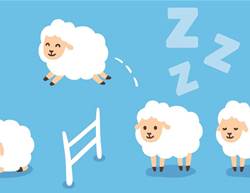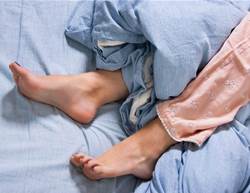When you sleep, your muscles relax, including those in your tongue and pharynx (throat). This usually doesn’t cause any problems, but if your throat closes up completely, you’ll stop breathing. When that happens, your oxygen levels drop, triggering your brain to stimulate your body to jerk and rousing you to start breathing again.
This is called obstructive sleep apnoea (OSA). Apnoea is the medical term for stopping breathing, and it’s ‘obstructive’ because your upper airways collapse intermittently while you’re asleep, blocking the flow of air into your lungs.
In more severe cases, these breathing pauses and jerks can happen hundreds of times a night. As you rouse, you may grunt or gasp, then relax again and go back to sleep. The next day, you may not remember doing it. I’ve noticed among my patients that it’s often partners who drag them to see me, terrified by repeatedly seeing or hearing their loved one stop breathing.
These arousals disrupt your sleep pattern and quality, leading to increased daytime tiredness.
Do I have sleep apnoea?
Sleep apnoea is pretty common: the Sleep Health Foundation estimates it affects about 5% of Australians. It may run in families, too.
In one study, more than two in three people diagnosed with sleep apnoea had another family member with the same condition. Being overweight is a major risk factor, making you more prone to narrowing of the pharynx during sleep.
Other conditions, such as underactive thyroid, Down syndrome and polycystic ovary syndrome (PCOS), have all been associated with the condition.
It is also more likely if you:
- have a large neck size (40 centimetres or more for women)
- have type 2 diabetes
- have heart disease
- are in the late stages of pregnancy
- have a persistently blocked nose
- have a small or set-back lower jaw
Sleeping tablets and alcohol, as well as smoking, also increase your risk.
What are the symptoms of sleep apnoea?
The big clue as to whether you might be at risk of sleep apnoea is snoring. One US study showed that 96% of snorers had some degree of sleep apnoea when they were tested.
Your doctor will also be alerted to the possibility of sleep apnoea if you experience these symptoms:
- waking feeling unrefreshed despite an apparently good night’s sleep
- insomnia or fragmented sleep
- headaches on waking
- unexplained sleepiness or tiredness
- waking up to empty your bladder
- choking during sleep
- difficulty concentrating or poor memory
- a partner witnessing episodes where you stop breathing while asleep.
Should I worry?
Sleep apnoea won’t stop you breathing permanently, so don’t fret too much – your brain will trigger you to wake up as soon as it detects low oxygen levels. But, it can have a significant impact on your quality of life if you’re constantly tired.
Plus if you’re sleep deprived due to sleep apnoea, you may be up to nine times more likely to be involved in a road traffic accident.
But there are other, less obvious consequences, too. Untreated sleep apnoea has been linked to a higher risk of high blood pressure, heart attack, stroke, heart failure (where your heart can’t pump blood efficiently enough around your system, leading to fluid build-up in legs and lungs), abnormal heart rhythms, such as atrial fibrillation, and even type 2 diabetes.
While it’s not entirely understood how sleep apnoea can lead to these serious health consequences, it’s thought that it might be linked to its effect on the pressure inside your chest cavity, inflammation in the body and being in a repeated high state of alert.
Getting a diagnosis
If you’re presenting with symptoms, your doctor will likely ask you to complete the Epworth Sleepiness Scale (developed by Aussie Dr Murray Johns at the Epworth Hospital in Melbourne), which is routinely used to rate how much impact daytime sleepiness is having on your life.
You score how likely you are to doze off during eight routine activities, including watching TV or sitting in a car. For each activity, you score 0 if you’d never doze, and up to 3 if there’s a high chance you’d doze off. A total score of at least 16 means you have ‘severe excessive daytime symptoms’ and need investigation.
If your symptoms and sleepiness score suggest moderate or severe OSA (or if your symptoms are having a big impact on your life), your doctor should refer you to a sleep clinic.
Here, the team will arrange tests, some of which (an oxygen monitor worn on your finger or a respiratory polygraph that measures your breathing while you sleep) can be done at home.
You may also need to go into the hospital to be monitored overnight. Tests may involve measuring your blood oxygen, breathing rate, night movement and/or brain waves.

What sleep apnoea treatments are available?
Regardless of the severity of your symptoms, you’ll be advised to avoid sedative tablets, drinking too much alcohol and smoking, and to lose weight if you’re carrying extra kilos.
If you have mild sleep apnoea that isn’t significantly affecting your quality of life, you usually won’t need other treatment. But if your snoring affects you or your partner, you could try techniques to stop you lying on your back (such as sewing a tennis ball into the back of your nightwear – yes, it’s a thing).
You could also put a full-length pillow behind your back. There’s also an electronic device, called a NightShift Active Sleep Repositioner and Recorder, which is worn around the neck and vibrates when the sleeper lies on their back, training them to doze on their side.
If your symptoms are more severe, the standard treatment is CPAP (continuous positive airway pressure) – a simple machine sends slightly pressurised air into your lungs at night via a mask, to keep your airways open.
It’s usually highly effective, but can take a lot of getting used to because of the need to wear a mask and the noise it makes. It works best if worn all night, but people with milder sleep apnoea may only need to use it for about four hours a night.
If CPAP isn’t suitable, you may be offered a custom-made mandibular advancement splint to wear in your mouth at night. These bring your jaw forward, stopping your tongue lolling back and your throat closing.
eXciteOSA is a new prescription-only silicon mouthpiece that’s now available in Australia. It works by using a mild electrical current to stimulate and improve muscle function in the tongue. It’s designed to be used for 20 minutes a day, initially for six weeks, and studies show it’s effective in reducing snoring, sleep apnoea episodes and daytime sleepiness.
This article originally appeared in the May 2023 issue of Good Housekeeping UK.









